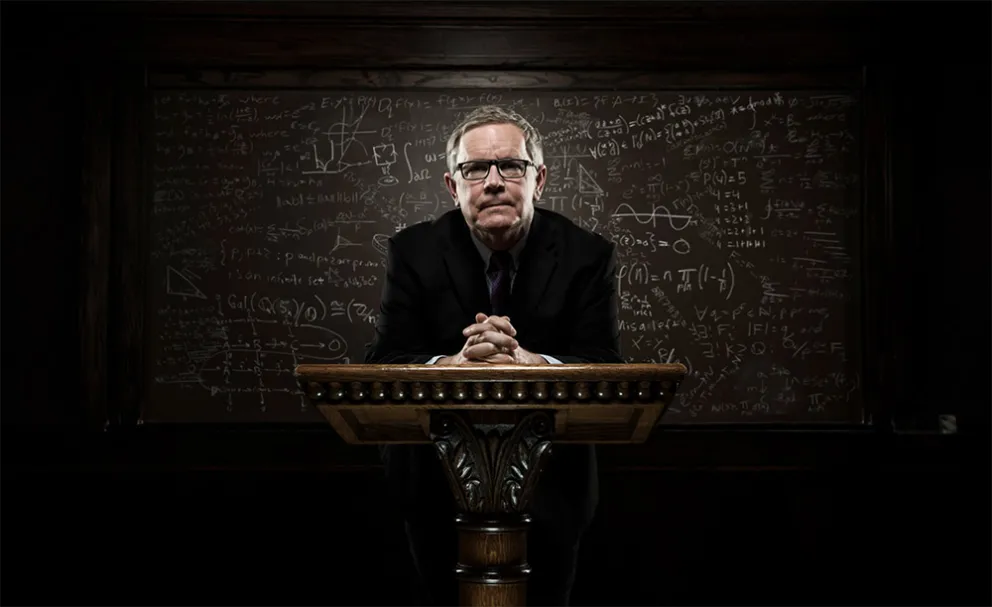
(Text by Nate Edwards, photos by Nate Edwards and Jaren Wilkey, BYU) Nate Edwards' photo "President of Math" was voted 1st place in People & Portraits in the September 2017 MIC.
THE BACK STORY
Our very own BYU Math Department Chair, Michael Dorff, was going to be sworn in as the new president of the Math Association of America (MAA) and I (Nate Edwards) was given the assignment to take a photo of him for our news release. I sat with other coworkers and we bounced ideas around of how we wanted to illustrate this. Initially I wanted this to be a humorous photo with him in a bowtie, but with dramatic/serious lighting, and chalkboard filled with math equations as the backdrop. I thought the contrast of a silly-ish photo with serious lighting would be interesting. We even discussed having his math bodyguards behind him with thick taped up glasses standing next to the math flag (is there even such a flag?).
With all the ideas floating around, we needed to find the perfect location. I walked around campus looking for a chalkboard in the perfect classroom, only to find… nothing. It didn’t seem there were any chalkboards on campus! Only whiteboards. My dreams of the perfect classroom seemed gone! Since I am still relatively new to campus I recruited Jaren (Wilkey, Manager of BYU’s University Photography Office) to help me find one. We ended up walking all over campus hunting for any chalkboard.
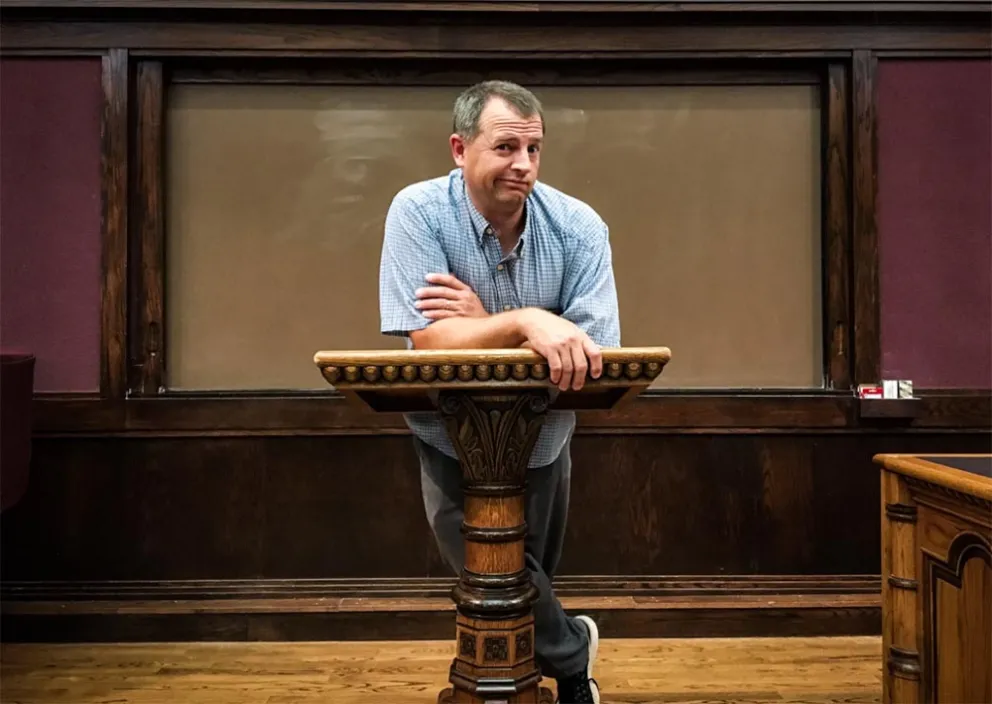
Jaren Wilkey posing at the pulpit in front of the glorious chalkboard we found!
We searched for quite a while, and finally found some chalkboards in the science building– it wasn’t quite what we were hoping for, but we could make it work if we needed to. At least we had found a chalkboard! Still determined, we continued our search until we found the perfect location! Old dark wood panels, hardwood floor, a nice podium, and a chalkboard! This place was what dreams were made of, at least for what I had in mind.
RECRUITING HELP
I set up an appointment with Michael Dorff (I will refer to him from here on out as MPOTUS) on a day we could reserve the room and gave him a little insight in what we wanted to do and what to wear. I also went and recruited some grad students in the math department to help with filling the chalkboard with math equations and such. I wanted the equations to be real and authentic. Math was the subject that almost held me back from graduating, so I was the last person I wanted to grace the chalkboard with my skills. I made sure to offer them some sweet portraits for helping me out!
As a side note, I have found it is important to reach out to people who know more about certain subjects than we do to help us when we need it. As university photographers, we have so many assignments with such great variety it almost seems we need to be experts in everything to make sure it is accurate and believable! Well, I am far from that guy. So, I rely heavily on those that know more than me about things I don’t really understand… which is most things beyond the realm of camera settings, lighting, composition, etc. And sometimes I even struggle with that.
I had the math students come two hours or so before the actual photo shoot so we could make sure the chalkboard was all set to go, and the lighting was all set up before MPOTUS got there. Whenever you are dealing with teachers, deans, presidents, etc. odds are, they have a busy schedule, so I try to have everything ready and in place when they get there to be efficient and respectful of their time.
While we were waiting for MPOTUS to arrive, I took some photos of the graduate students that helped me out to say "thank you" and so we could have some stock photos to put on our website.
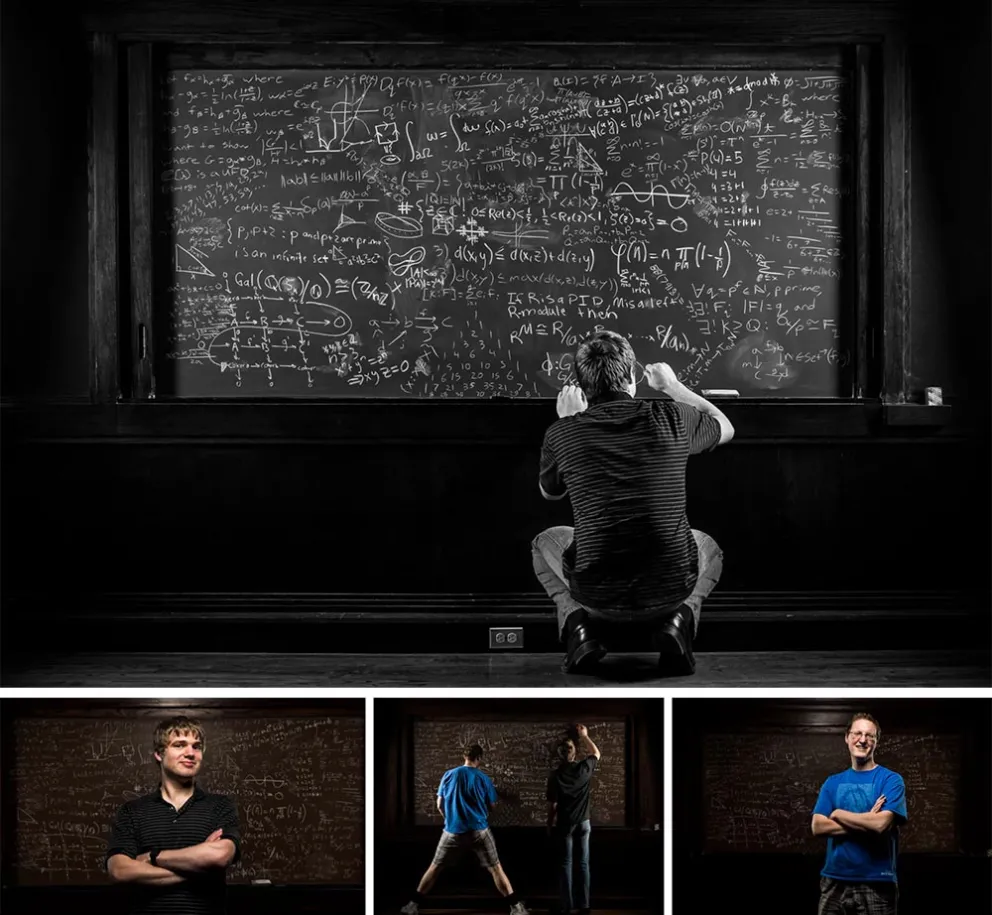
When I contacted MPOTUS initially, he mentioned he would like to get some photos of him teaching students as well. Although that wasn’t what I had in mind, I thought that would be great to get those photos as well so we could add them to our online stock gallery, and it would also be fun for them to have afterwards. The dramatic lighting I was planning on wouldn’t have worked so well for that, so we set up two different lighting scenarios: one more dramatic, and the other more soft and bright.
I programmed the lights in each lighting scenario to the same channel but a different group so I could quickly change which setup I wanted to use (example: I would be on channel 20 but program one setup as A and the other as B. Then all I needed to do was switch what group I was wanting on the back of my pocket wizard. I don’t know if that is the correct terminology or not- I just work here.)
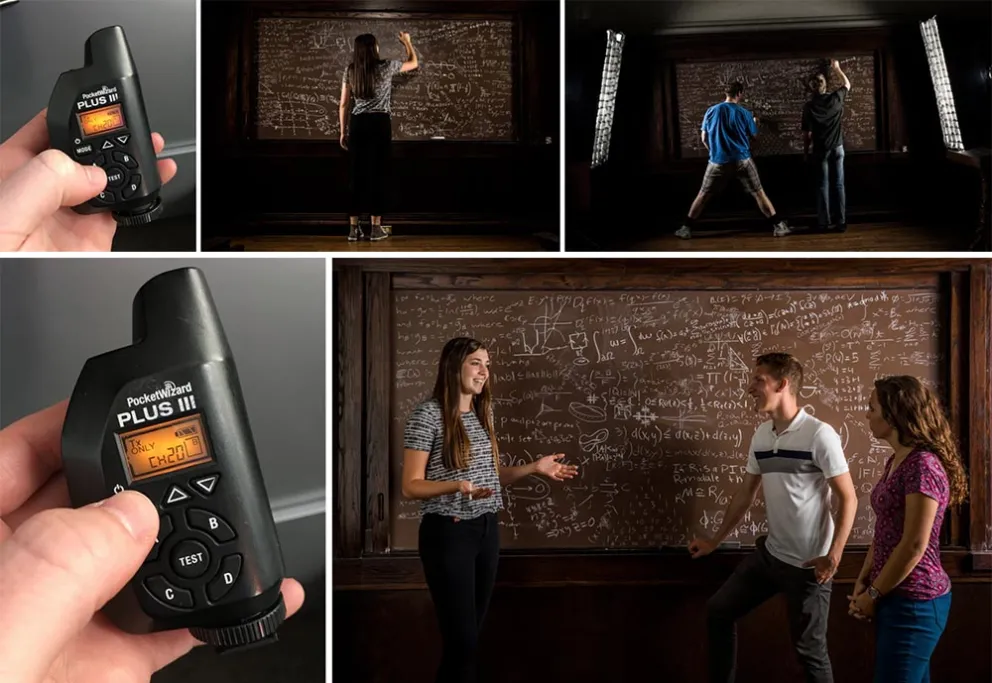
Below is a birds-eye view of the lighting setup with the lights labeled "A" or "B" to show which lights were on each group. On group "A" I used strip boxes behind him to create a rim-light and grids on the strip boxes to have better control over the direction of the light and to reduce lens flare (since the lights are pointing towards the camera). I also used a beauty dish as my key light almost directly above to add to the dramatic feeling. On group "B" I put up the big white silk with two lights behind it to get a big soft side light for my key light, and then a large fill on the other side so the shadows weren't so dark. Don't ask me what the power the lights were set to– I guess I am little more postmodern when it comes to my lighting... I just play with it ‘till it looks the way I want.
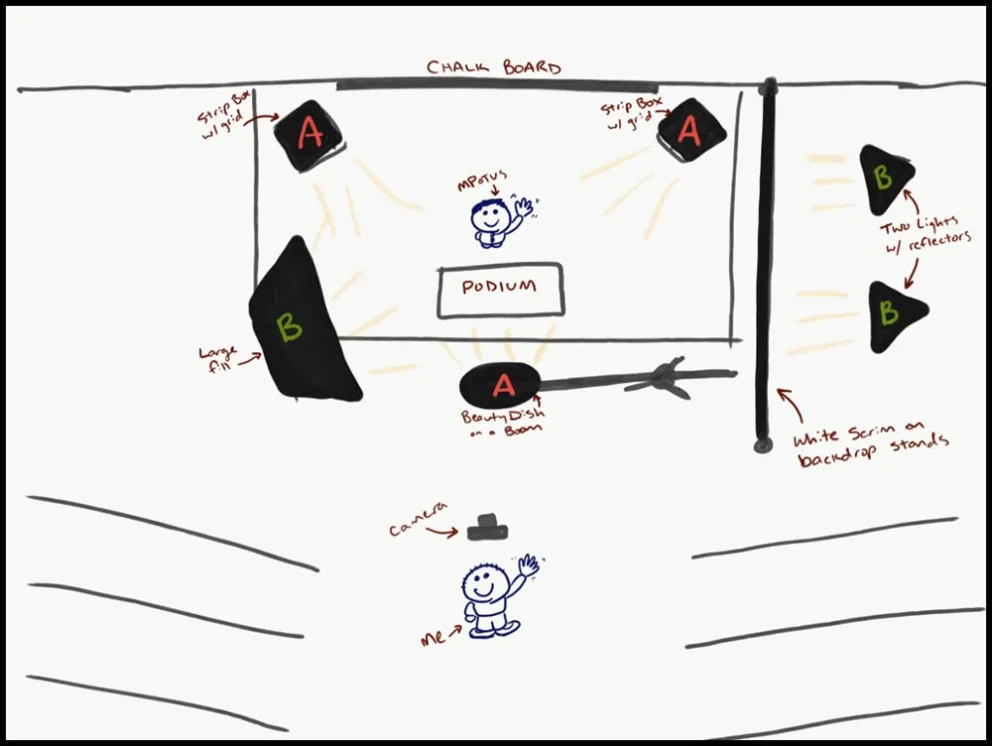
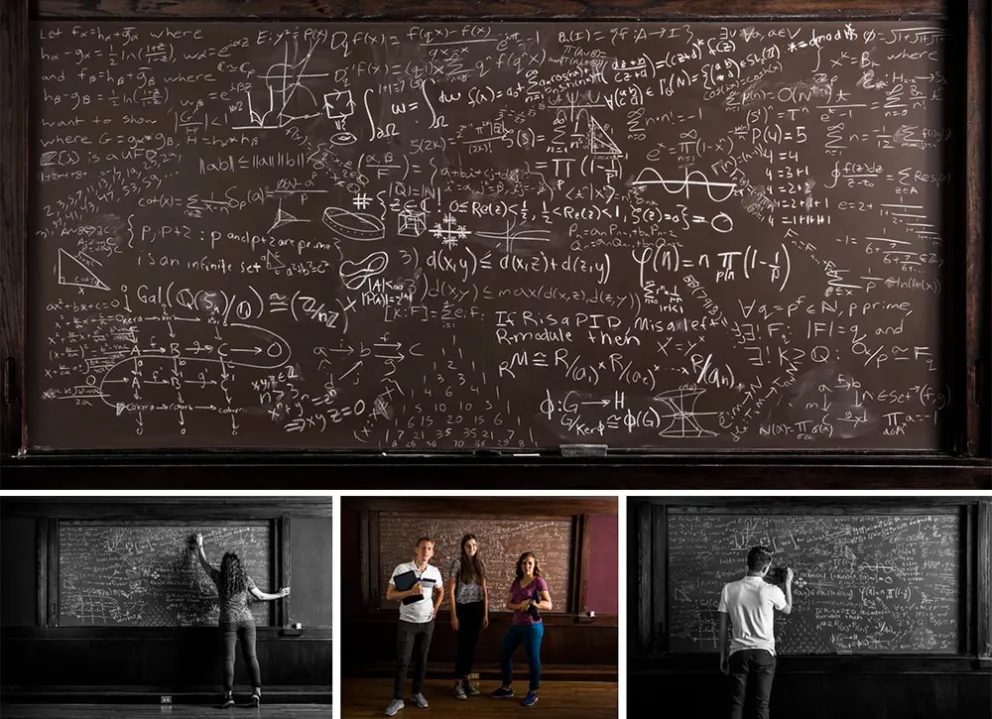
MPOTUS ARRIVES
When MPOTUS arrived, I ran through what the plan was and gave him some direction. I also asked if he was comfortable wearing a bowtie. He laughed a little and said he doesn’t wear bowties and didn’t really want to wear one. Although that was one of the things I wanted for this photo, I still want to make sure I am respectful of what other people are willing to do or comfortable doing, and make adjustments accordingly. There is a fine balance of convincing someone to go with your ideas and pushing them into doing something they don’t want to do. In this instance, I felt the suit and tie he already had on would work just fine.
As we were taking photos, I realized I wanted another light below the podium to define its edges more because it was getting lost in the shadow. Thanks to having assistants on hand, they were able to put one on the floor below the podium to give just the right touch in just a few seconds.
That is one thing I enjoy about transferring images wirelessly to my iPad while I am shooting (we use ShutterSnitch)--It helps me slow down a little bit so I can notice things I would want to change. I also try to have one of our students look at it while I am taking photos to point things out they might see wrong because I sometimes get tunnel vision and miss little things just looking at a small LCD on the back of my camera... and sometimes I get back to go through my photos and realize I miss BIG things too.

"HAPPY ACCIDENT"
At one point while shooting, I went to switch between lighting scenarios on my pocket wizard and accidently turned both groups on without realizing it. As Bob Ross would say, it was a “happy accident” and I now had a 3rd lighting scenario I wasn’t planning on, but one I thought worked quite nicely.

After we took some photos at the podium, we moved it out and took some photos of him by the chalkboard looking at the camera, and interacting with his students that were seated behind me to get some variety. We were done with his portrait within 20 minutes of his arrival.
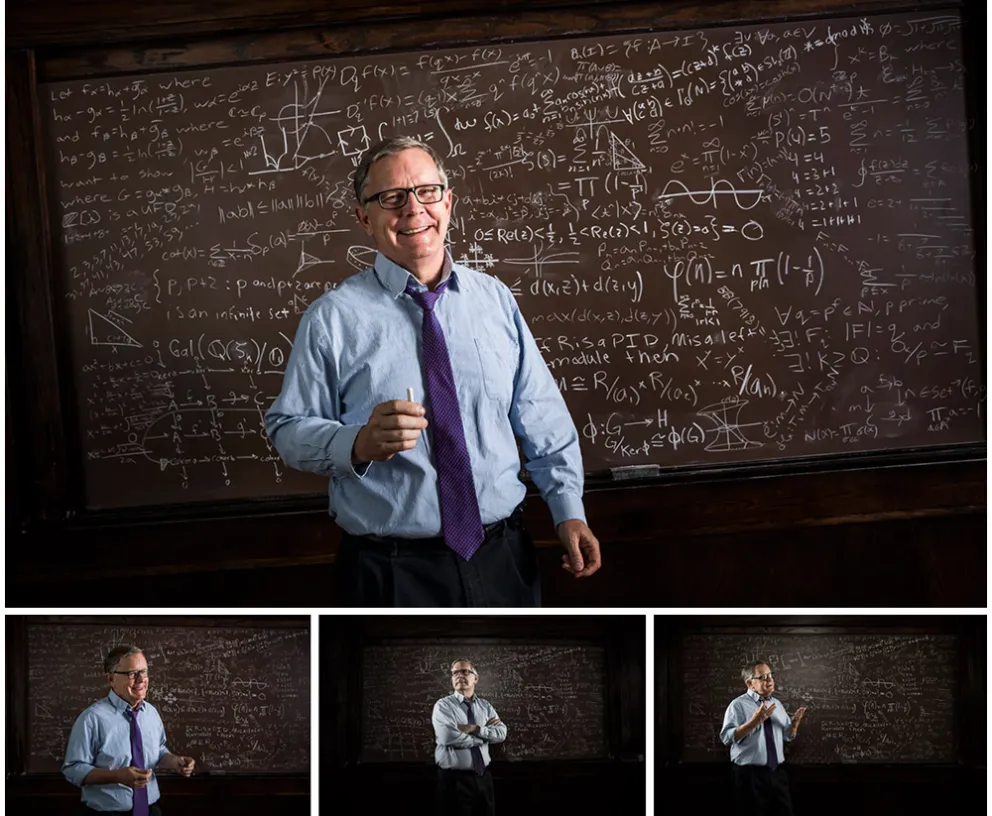
Another side note: I try to let the subject know ahead how much time they should block out. Also during the photo shoot, I try to read their body language and comfort level and adjust the time of the shoot accordingly. If I can tell they are really busy and don’t want to be there, I try to make them comfortable the best I can and cut the photo shoot shorter, while still making sure I get something that will work well for the assignment. But if they are great to work with and we are having a good time, as was the case with MPOTUS, we keep it going until the time is up. I always want to make sure people have a good experience when they work with BYU Photo. I don’t know if this approach is right or wrong, it is just what I found works for me.
BRINGING IN THE STUDENTS
We then invited his students to come up and join him to get the photos he was wanting as well. I don’t know many people that smile while talking about math (although I’m sure they could have) so I had them talk about something else that probably had nothing to do with math where they can act natural, relax, and be involved in genuine conversation. The nice thing about the camera is that it has no idea what anyone is saying, so they can talk about whatever they want.
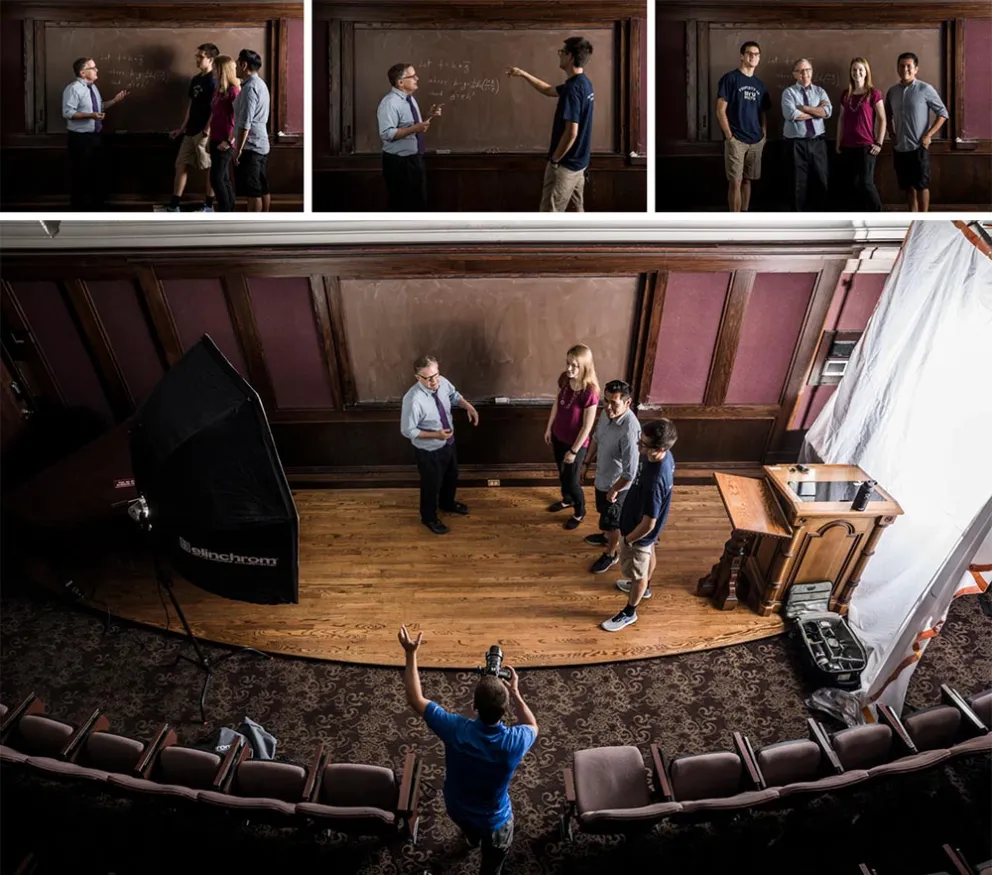
CONCLUSION
If I were to do this photo shoot again, I think I would have spent a little more time setting up the scene, working with a designer to possibly make an official-looking math seal to incorporate on the podium or math flags to place on both sides of the chalkboard in the background– something that would communicate "President" a little more.
Either way, this was a fun photo shoot that required a lot of pre-planning, and a lot of help setting up. Michael Dorff and his students were great to work with, and there is no way I could have pulled it off alone. One thing I was reminded of on this photo shoot was the importance of having a plan, yet being willing to adapt when things don’t go exactly how you want them to. Also, behind every good photo, there is an amazing support staff. I probably shouldn’t speak in absolutes like that, but you know what I’m saying. Our fellow co-workers in University Communications and our student employees are vital to our success. We really could not do what we do without them here at BYU Photo.
BE SURE TO WATCH THE BEHIND THE SCENES VIDEO BELOW!
Thanks to the BYU staff for their generosity and apologies for having to ruin their beautiful exposure.com presentation. “What time did the man go to the dentist? Tooth hurt-y” Blog stories/ideas welcome any time, email editor Matt Cashore at mcashore@nd.edu